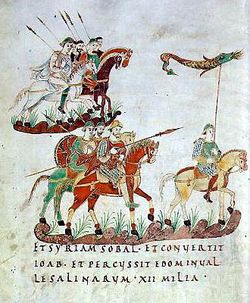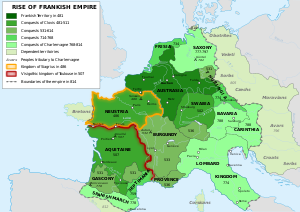774
| القرون: | قرن 7 · قرن 8 · قرن 9 |
| العقود: | ع740 ع750 ع760 ع770 ع780 ع790 ع800 |
| السنوات: | 771 772 773 774 775 776 777 |
| ألفية: | الألفية 1 |
|---|---|
| قرون: | القرن 7 – القرن 8 – القرن 9 |
| عقود: | عقد 740 عقد 750 عقد 760 – عقد 770 – عقد 780 عقد 790 عقد 800 |
| سنين: | 771 772 773 – 774 – 775 776 777 |
| 774 حسب الموضوع | |
| السياسة | |
| زعماء الدول – الدول ذات السيادة | |
| تصنيفات المواليد والوفيات | |
| المواليد – الوفيات | |
| تصنيفات التأسيسات والانحلالات | |
| تأسيسات – انحلالات | |
| التقويم الگريگوري | 774 DCCLXXIV |
| آب أوربه كونديتا | 1527 |
| التقويم الأرمني | 223 ԹՎ ՄԻԳ |
| التقويم الآشوري | 5524 |
| التقويم البهائي | −1070 – −1069 |
| التقويم البنغالي | 181 |
| التقويم الأمازيغي | 1724 |
| سنة العهد الإنگليزي | N/A |
| التقويم البوذي | 1318 |
| التقويم البورمي | 136 |
| التقويم البيزنطي | 6282–6283 |
| التقويم الصيني | 癸丑年 (الماء الثور) 3470 أو 3410 — إلى — 甲寅年 (الخشب النمر) 3471 أو 3411 |
| التقويم القبطي | 490–491 |
| التقويم الديسكوردي | 1940 |
| التقويم الإثيوپي | 766–767 |
| التقويم العبري | 4534–4535 |
| التقاويم الهندوسية | |
| - ڤيكرام سامڤات | 830–831 |
| - شاكا سامڤات | 696–697 |
| - كالي يوگا | 3875–3876 |
| تقويم الهولوسين | 10774 |
| تقويم الإگبو | −226 – −225 |
| التقويم الإيراني | 152–153 |
| التقويم الهجري | 157–158 |
| التقويم الياباني | Hōki 5 (宝亀5年) |
| تقويم جوچى | N/A |
| التقويم اليوليوسي | 774 DCCLXXIV |
| التقويم الكوري | 3107 |
| تقويم مينگوو | 1138 قبل جمهورية الصين 民前1138年 |
| التقويم الشمسي التايلندي | 1317 |
Year 774 (DCCLXXIV) was a common year starting on Saturday (link will display the full calendar) of the Julian calendar. The denomination 774 for this year has been used since the early medieval period, when the Anno Domini calendar era became the prevalent method in Europe for naming years.
أحداث
حسب المكان
الامبراطورية البيزنطية
- معركة بيرزيتيا: الحاكم البلغاري (خاقان) Telerig sends a small raiding army (12,000 men) to strike into the southwest of Macedonia، and capture Berzitia. Emperor Constantine V is informed about this raid by his spies في پليسكا، and assembles an enormous force (80,000 men). He surprises the Bulgarians، who did not expect to find a Byzantine army there, and defeats them decisively. The Bulgars suffer heavy losses.
- Telerig sends a message to Constantine V, stating that he is going to flee in exile to Constantinople. In exchange, he asks the emperor to reveal the spies to his associates in Pliska for their own safety. Constantine sends the Bulgarian government a list of the spies; however, Telerig executes them all, and eliminates the Byzantine spy network within his government.[1]
أوروپا

أثناء حملة شارلمان على اللومبارد، الفرنجة يحتلون عاصمة اللومبارد پاڤيا، ولاحقاً برگامو بعد حصار استمر تسعة أشهر.
- الملك شارلمان conquers the Lombard Kingdom، and establishes Frankish rule in پاڤيا، Venetia، إيستريا، Emilia، توسكانيا، و كورسيكا. Charlemagne visits Rome; he confirms the Donation of Pepin (see 756) while insisting on his own sovereignty. Pope Adrian I grants him the title of patrician. Charlemagne puts down immediate insurrections in فريولي.
- يونيو - الملك Desiderius surrenders the independence of the Lombards to the Franks، and is exiled to Corbie Abbey (Picardy). Charlemagne annexes northern Italy as a sub-kingdom, and takes the title of Rex Langobardum. Some Lombards flee south to Benevento، which remains independent; Duke Arechis II يغيّر لقبه إلى "Prince of Benevento".
- Saxon Wars: Saxon raiders ravage much of northern Hesse (modern Germany), and burn the abbey at Fritzlar، putting the abbot and monks to the sword. Charlemagne hurriedly returns to Austrasia، assembles local troops, and recaptures Eresburg، before the approach of winter halts further operations.[2]
- الملك Aurelius dies after a 6-year reign, and is succeeded by his cousin-in-law Silo، as ruler of Asturias (شمال اسبانيا).
بريطانيا
- Unrest in the Northumbrian Church appears to lead to the expulsion of King Alhred، who is driven from his capital York. He sails from Bamburgh into exile amongst the Picts، where he is received by King Ciniod I. He is replaced by Æthelred I، the 11-year-old son of the late king Æthelwald Moll.
- الملك أوفا من مرسيا يُخضِع الممالك الأنگلو-ساكسونية كنت و وسكس (تاريخ تقريبي).
حسب الموضوع
الفلك
ثمة شيء ما قد حدث في عام 774 وكان قوياً لدرجة أنه كان بالإمكان قياس النشاط الإشعاعي في حلقات الأشجار القديمة. أفضل تخمين هو اندلاع شمسي، عشرة أضعاف حادث كارنجتون في 1859 الذي صعق أسلاك التلغراف.
- نمو 1.2% في تركز 14 C المسجل في حلقات الأشجار، بجانب الارتفاعات الشوكية المناظرة في 36 Cl و 10 Be المسجلة في أسطوانات الجليد، تقترح أن عاصفة شمسية شديدة القوة ربما تكون قد ضربت الأرض في عام 774 أو 775.[3]
مواليد
- أبو عبيد القاسم بن سلام، عالم لغة وفقيه ومحدث وإمام من أئمة الجرح والتعديل. († 837)
- كوكاي، راهب بوذي ياباني (ت. 835)
وفيات
مجهولة التاريخ
- عبد الرحمن الاوزاعي، Muslim scholar (و. 707)
- أبو مخنف، مؤرخ مسلم (تاريخ تقريبي)
- Amoghavajra، مترجم صيني (و. 705)
- Kim Daeseong، وزير كوري (و. 700)
- Aurelius، king of Asturias (اسبانيا)
محتملة
- Gummarus، Frankish nobleman and saint (و. 717)
- كريشنا الأول، حاكم امبراطورية راشتراكوتا[4]
المراجع
- ^ قالب:The Early Medieval Balkans
- ^ David Nicolle (2014). The Conquest of Saxony AD 782–785, p. 14. ISBN 978-1-78200-825-5
- ^ Mekhaldi, Florian; Muscheler, Raimund; Adolphi, Florian; Aldahan, Ala; Beer, Jürg; McConnell, Joseph R.; Possnert, Göran; Sigl, Michael; Svensson, Anders; Synal, Hans-Arno; Welten, Kees C. (2015-10-26). "Multiradionuclide evidence for the solar origin of the cosmic-ray events of AD 774/5 and 993/4". Nature Communications (in الإنجليزية). 6 (1): 8611. doi:10.1038/ncomms9611. ISSN 2041-1723.
- ^ Pandurang Bhimarao Desai (1970). A History of Karnataka: From Pre-history to Unification. Kannada Research Institute, Karnatak University. p. 115.
This article contains content from Wikimedia licensed under CC BY-SA 4.0. Please comply with the license terms.


